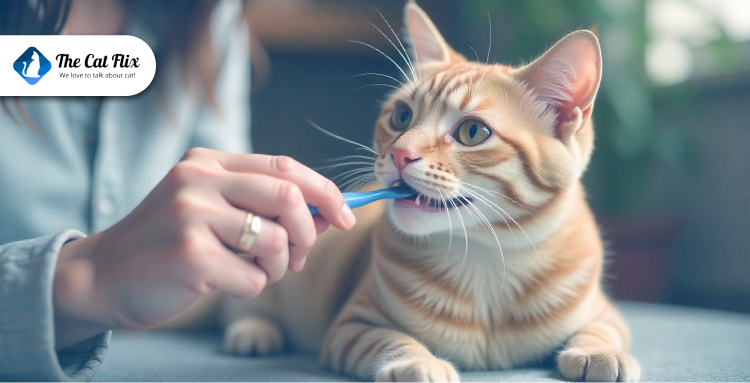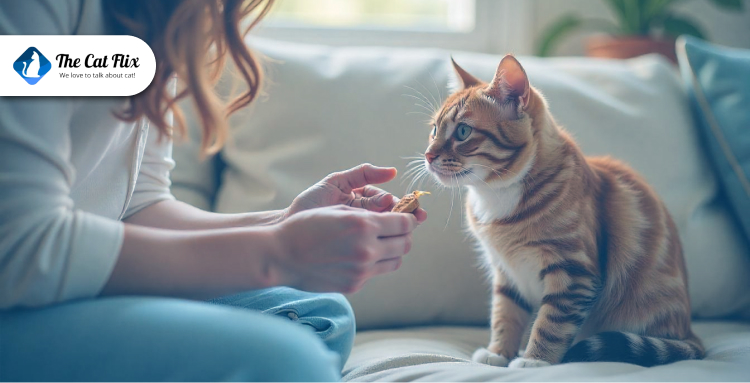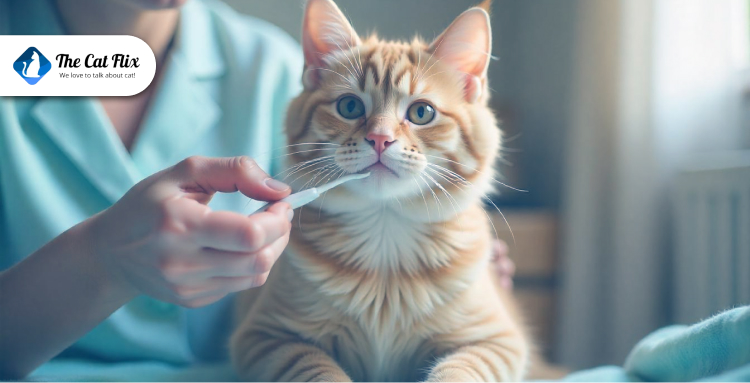Let me tell you a fact, by the age of three, nearly 70% of cats already show signs of dental disease. It’s that common—however, here’s the problem: brushing a cat’s teeth can feel like trying to give a bath to a tiger. If you’ve ever tried, you know the struggle—wiggling, clawing, dramatic escapes, and maybe even the silent treatment afterward.
Cleaning their teeth doesn’t have to turn into a claw-filled showdown. I get it—most of us would rather wrestle a wet towel than stick a toothbrush in a cat’s mouth. That’s why I’ve put together this no-stress guide to keeping your kitty’s teeth clean, without losing your sanity (or your fingers).
1) Why Cats Need Dental Care
Let’s get real—cats aren’t out here brushing their own teeth, and that’s where the trouble starts. However, just like us, cats can suffer from plaque, tartar buildup, and gum disease (gingivitis & periodontitis) —and ignoring their dental health can lead to painful infections, tooth loss, and even problems with their heart, kidneys, and liver.
Signs of Trouble: When to Act
Cats are experts at hiding pain, so dental problems can go unnoticed until they’re serious. Here’s what to watch for:
- Bad breath (strong fishy odor).
- Drooling (excess saliva tinged with blood).
- Pawing at the mouth.
- Difficulty eating (suddenly prefers soft food or drops kibble while eating).
- Yellow or brown tartar buildup
Is Professional Cleaning Necessary?
If your cat is older or already has tartar buildup, starting with a vet-approved dental cleaning might be the best move. Unlike at-home care, professional cleanings go below the gumline, removing hidden bacteria and preventing future problems. Yes, it involves anesthesia, but the risks of skipping dental care are much higher. Once your cat’s teeth are clean, you can maintain their oral health without brushing—and I’ll show you how in the next section.
Also read: How to Take Proper Care of a Senior Cat?
2) Setting the Stage for Success
Cats aren’t exactly known for their patience, especially when it comes to having their mouths messed with. However, you can make dental care way easier by setting the right vibe. With a little patience, good timing, and the perfect setup, you can turn what seems like an impossible task into a stress-free routine.

Patience and Positivity Win the Day
Cats pick up on your energy, so if you go in expecting a battle, they’ll sense it—and fight back. Instead of stressing, stay calm, and be patient. Even if all you do is let them sniff a dental wipe or chew on a dental treat today, that’s progress.
A few mindset shifts that help:
- Go slow – No need to rush. Let your cat warm up to the process.
- Reward, don’t restrain – Treats, praise, and gentle pets work better than force.
- Stay consistent – A little effort every few days is better than one stressful session a month.
When to Approach Your Cat
Picking the right moment is half the battle. If your cat is zooming around the house like a tiny tornado, it’s probably not the best time. Instead, try these:
- Post-nap time – Cats are naturally more relaxed after sleeping.
- After playtime – A little play session helps burn off excess energy.
- During cuddle time – If your cat enjoys petting, use that moment to gently touch their mouth and introduce dental care.
Avoid trying to clean their teeth when they’re hungry, overstimulated, or in full “leave me alone” mode.
Create a Calm Space
The right setup can make all the difference. Here’s how to create a stress-free dental care zone:
- Soft surface – A cozy blanket or your lap helps them feel safe.
- No distractions – Pick a quiet room with no loud noises or sudden movements.
- Soft lighting – Harsh lights can make cats uneasy. Keep things mellow.
3) Step-by-Step: Brushing Without the Battle

Brushing your cat’s teeth might sound like a nightmare, however the key is to ease into it, reward every step, and stop before your cat gets annoyed. Here’s how:
-
Step 1: Build Trust (Days 1-3)
First things first—get your cat cool with you poking around their mouth. Start easy: use your finger to gently rub their lips or gums for a few seconds. No rush, just a quick touch. Then, hit them with a treat or a “who’s the best kitty?” They’ll start connecting your finger with good stuff. Do this daily for three days. The goal? Make it no big deal. By day three, my cat, Milo, was purring instead of plotting my demise—progress.
-
Step 2: Introduce Tools (Days 4-7)
Now, bring in the gear. Grab a cat toothbrush (soft bristles, tiny head) or a finger brush if they’re less fussy about it. Pair it with enzymatic toothpaste—poultry or fish flavors are usually winners (human toothpaste’s a no-go, it’s toxic). Let them sniff or lick the stuff first—don’t shove it in their face. Take a few days to let them get curious. I left the brush out for Milo to inspect; by day seven, he was licking the toothpaste like it was a snack. No pressure, just vibes.
More to read: What To Do If My Cat Ingest Foods That Are Toxic
-
Step 3: Start Small (Week 2)
Time to brush—barely. Lift their lip, pick 1-2 teeth, and swipe for 10 seconds, focusing on the outer surfaces (inside’s less critical). Use gentle moves, not a scrub-fest. Watch their mood—stop the second they twitch or glare. Then, pile on the treats or praise like they just won an Oscar. Short and sweet keeps it stress-free. Week two with Milo? I hit his front teeth, and he didn’t even flinch—huge win.
-
Step 4: Level Up (Week 3+)
Ramp it up a bit. Aim for 30 seconds per side, targeting those back molars where plaque loves to camp out. Use soft, circular motions—like you’re polishing, not digging for gold. No forcing it; if they squirm, call it a day. Vets say: outer surfaces matter most, so don’t sweat the rest. Milo’s back teeth were gnarly, but after a few sessions, I could see less junk building up. Patience pays off.
-
Step 5: Making It a Habit
How often? Daily’s the dream, but 2-3 times a week works for most of us mere mortals. Find your groove—tie it to something like feeding time or your evening Netflix binge. Stick with it, and you’ll spot fresher breath and less tartar creeping in. I synced Milo’s brushing with my coffee routine; now it’s just part of the day. Track the wins: if their breath doesn’t knock you out anymore, you’re nailing it.
4) Signs Brushing Might Not Work

Sometimes, brushing just not in the cards—and that’s okay. If your cat’s still freaking out after a couple weeks, look for clues it’s a lost cause: constant hiding, aggressive pushback, or zero progress despite your best tricks. Cats with past trauma or super-sensitive mouths might never vibe with it. Vets see this a lot—some cats are better off with alternatives like dental treats or pro cleanings. Milo’s sister, Max, never got past the swat phase; I switched to a dental gel, and we’re both happier for it. Know when to wave the white flag and try Plan B.
5) When to Call the Vet
Even with the best home care, some dental problems need professional help. Cats are experts at hiding pain, so by the time they show signs of trouble, things might already be serious. Knowing when to call the vet can save your cat from unnecessary pain—and save you from bigger vet bills down the road.
Red Flags: Signs Your Cat Needs a Vet Visit
- Bleeding or inflamed gums – A little redness is okay, but if you see swelling, bleeding, or pus, it could mean gum disease or infection.
- Persistent bad breath – Mild “cat breath” is normal, but a foul, rotten smell can be a sign of tooth decay, infection, or kidney issues. (Also read: How to Spot the Early Signs of Kidney Disease in Cats)
- Broken, loose, or missing teeth – If a tooth looks cracked, chipped, or wobbly, your cat is likely in pain and needs a vet check ASAP.
Even with regular home care, most cats still need professional dental cleanings every 1-2 years. The procedure usually takes about an hour or two, and costs can range from $200 to $500, depending on your location and your cat’s condition. As Milo’s vet once said, ‘Home care is important, but it can’t replace professional checkups. Even if you brush daily, tartar can build up in places you can’t reach. Routine dental cleanings keep your cat’s teeth and gums healthy and help prevent painful problems down the road.‘
Conclusion
So, there you have it—cleaning your cat’s teeth doesn’t have to be a claw-and-tooth struggle. It’s all about taking it slow, staying chill, and knowing when to switch gears if your kitty’s not onboard. Whether you’re rubbing their gums with a finger or letting the vet handle the heavy lifting, you’re keeping their mouth happy and their purrs strong. Start small tonight—maybe just a quick lip touch and a treat.
Have you tried brushing your cat’s teeth? Got any funny or helpful tips? Drop a comment below and share your experience! And if you found this guide useful, share it with a fellow cat parent.

